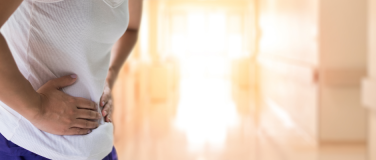
Maybe you’ve assumed that acupuncture is painful or that it’s an outdated, ancient practice. As a nurse, I know I used to be a little skeptical of it. Putting needles into someone to help reduce pain? No way that could work.
But it turns out I was wrong. The truth is, acupuncture doesn’t hurt! And while it has been used for centuries, it’s not outdated at all. Most importantly, there’s promising science behind how acupuncture works and why it may be helpful for you. One study found that those with endometriosis experienced a 62% reduction in their pain after four weeks of treatment. The rate of pain reduction was clinically significant, and pain reduction remained slightly greater at the 8 week and 6 month follow-up. However, the differences in pain reduction were not statistically significant after 4 weeks.
What is Acupuncture?
Acupuncture is a form of Eastern medicine. When used to accompany Western medicine, it’s important to define it through the lens of both practices.
As experienced acupuncturist Elisabeth Vitale, L.Ac. defines it, acupuncture works by “encouraging the proper flow of resources throughout the body.” These resources are what make up the blood, including cells of the immune system, nutrients, and other healing and life-giving properties. Other sources define acupuncture as a method to improve blood and Qi circulation. Qi, pronounced “chee”, are all forms of energy, from the earth to nerve impulses in your body.
Acupuncture is performed by putting fine needles into the skin at specific points, called acupoints, along a meridian. A meridian, also called jing luo, is an energy (or Qi) pathway. In Traditional Chinese Medicine (TCM), there are 12 main pathways and 361 acupoints. These meridians correspond with organs, including ones not recognized by Western medicine. If you compare this to Western anatomy and physiology, the meridians and acupoints are very similar.
Eastern Lens of Acupuncture
When blood or Qi becomes stuck, meaning it is not flowing as smoothly as it should, pain is created. Acupuncture relieves pain by encouraging this easy flow and movement of the blood and Qi. An acupuncturist will consider all symptoms and treat the person as a whole. This means that two people with the same diagnosis may have a different treatment and different needle placements, because they are radically different people.
Vitale shares that the key to understanding acupuncture “is to understand that there is no separation between mind and body.” She explains that “the state of our mind (or some would say heart) has a direct correlation with the state of our body and vice versa, and so they are treated as one. They are one.” This means that when the acupuncturist is doing their assessment, they are assessing and treating the entire body.
Talking about acupuncture can also be challenging in the West, because, as Vitale explains, “disease is classified in a totally different way in East Asian medicine.” Part of this is because of a difference in language. Original texts are written in Chinese and other East Asian languages, so some things get lost in translation. Vitale adds, “for example, when we refer to the kidney organ, it includes much more than what we in the West know as kidneys. It also includes reproductive health and therefore connection to our ancestry. It includes how our bodies do with cold and water, and how we respond to the winter season. It’s also connected to our exhalation. It relates to the health of our back and our bones. It’s connected to hearing. And it’s also related to how we process fear in our lives.”
Western Lens of Acupuncture
The Western lens defines acupuncture as working by encouraging blood flow to various parts of the body, increasing the body’s own pain-relieving molecules (endorphins), and increasing the immune response. This results in less pain and less inflammation. When it comes to endometriosis, there is some evidence that acupuncture reduces CA-125, an inflammatory marker elevated in those with endometriosis, and cellular estrogen levels, a hormone created locally in endometriosis cells.
Benefits for Endometriosis
1. Reduced Pain
Acupuncture can reduce pain by increasing our pain threshold and increasing our bodies release of endorphins, our natural pain reducer. Additionally, some studies also report acupuncture affects dopamine and serotonin levels, our feel-good hormones.
2. Improved Immune Function
Studies have shown that acupuncture increases our immune response by supporting our immune system. Our bodies produce white blood cells (WBC) to help us fight infection and diseases. Acupuncture appears to increase a type of WBC. These types of cells, called natural-killer cells, are the ones that attack cancerous cells and abnormal tissues. For endometriosis, this could possibly also apply to endometriosis lesions. It is known that there is an immune dysfunction component with endometriosis, so supporting the immune system would be very helpful.
3. Decreased Cellular Estrogen Levels
One study reported that acupuncture may suppress serum estradiol (a type of estrogen). This hormone is often high in endometriosis cells, partly because endometriosis lesions create their own local supply of estradiol. Because estrogen stimulates endometriosis tissue growth, this suppression may help to reduce lesion size and pain.
4. Decreased Inflammation
A 2017 study found that acupuncture can reduce serum CA-125 levels. This is a blood marker that is associated with high levels of inflammation, and can be elevated in those with endometriosis.
What to Expect
Assessments by your acupuncturist are different from your medical doctor. Your acupuncturist will assess your pulse, the temperature of your limbs, and the color of your tongue. They will also do an extensive verbal assessment, asking questions about your history and symptoms. Because your acupuncturist treats your body as a whole, and not just your condition, that initial session may be quite long. Usually, the first session is an hour to an hour and a half and subsequent visits are around 30 - 45 minutes.
Assessing one’s pulse and limb temperature provides feedback on one’s metabolism, which reflects hormone health as well as cardiovascular and nervous system function. Vitale adds, “This all helps with differential diagnosis and coming up with the most appropriate treatment plan."
So, be sure to tell your acupuncturist about all of the symptoms that you are experiencing, even if you don’t think they’re related. Being thorough will help them select the most appropriate needle placements, recommend the right herbs, and provide the most accurate and specific recommendations.
When will I see changes?
Perhaps this is what we all want to know- when will we see an improvement in our pain levels? Vitale advises that you should “expect that healing may take time. Sometimes patients feel improvement after one visit, sometimes it takes several treatments before there is enough improvement that change is perceptible.” Talk to your acupuncturist about what you should expect.
How to find an Acupuncturist
When it comes to finding an acupuncturist, Vitale recommends asking friends and healthcare professionals. “Not all acupuncturists have an active web or social media presence,” Vitale explains, “but chances are you might know someone who has an acupuncturist they love.” Around 1 in 10 people use, or have used, acupuncture. So start to ask around!
You can also ask members of your healthcare team for their recommendations, check with your insurance, or find an acupuncturist online. To find one online, check out these tools:
You should also know that not all types of acupuncture are the same; there are many different types and styles. Vitale explains that the styles are as diverse as East Asia itself because every region has, over time, developed its own way of practicing medicine.”
And variety can be a great thing. “If you don’t resonate with the first person you try, it’s worth trying someone else,” Vitale says. And remember, give it some time. It won’t be a cure for your endometriosis, but it could become one valuable tool in your management tool box.
Sources:
https://pubmed.ncbi.nlm.nih.gov/18794019/
https://trialsjournal.biomedcentral.com/articles/10.1186/s13063-018-2684-6
https://www.ncbi.nlm.nih.gov/pmc/articles/PMC5659600/
https://www.takingcharge.csh.umn.edu/what-is-acupuncture
https://www.frontiersin.org/articles/10.3389/fpsyg.2019.01353/full
https://kootenaycolumbiacollege.com/the-chinese-medicine-meridian-system/
https://www.ncbi.nlm.nih.gov/pmc/articles/PMC5153578/
https://www.ncbi.nlm.nih.gov/pmc/articles/PMC7215544/
https://www.acupuncturetoday.com/mpacms/at/article.php?id=28126
https://www.sciencedirect.com/science/article/pii/S200529011300174X








